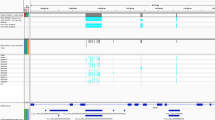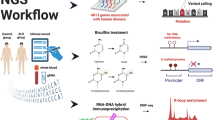Abstract
RBL2/p130, a member of the retinoblastoma family of proteins, is a key regulator of cell division and propagates irreversible senescence. RBL2/p130 is also involved in neuronal differentiation and survival, and eliminating Rbl2 in certain mouse strains leads to embryonic lethality accompanied by an abnormal central nervous system (CNS) phenotype. Conflicting reports exist regarding a role of RBL2/p130 in transcriptional regulation of DNA methyltransferases (DNMTs), as well as the control of telomere length. Here we describe the phenotype of three patients carrying bi-allelic RBL2-truncating variants. All presented with infantile hypotonia, severe developmental delay and microcephaly. Malignancies were not reported in carriers or patients. Previous studies carried out on mice and human cultured cells, associated RBL2 loss to DNA methylation and telomere length dysregulation. Here, we investigated whether patient cells lacking RBL2 display related abnormalities. The study of primary patient fibroblasts did not detect abnormalities in expression of DNMTs. Furthermore, methylation levels of whole genome DNA, and specifically of pericentromeric repeats and subtelomeric regions, were unperturbed. RBL2-null fibroblasts show no evidence for abnormal elongation by telomeric recombination. Finally, gradual telomere shortening, and normal onset of senescence were observed following continuous culturing of RBL2-mutated fibroblasts. Thus, this study resolves uncertainties regarding a potential non-redundant role for RBL2 in DNA methylation and telomere length regulation, and indicates that loss of function variants in RBL2 cause a severe autosomal recessive neurodevelopmental disorder in humans.
This is a preview of subscription content, access via your institution
Access options
Subscribe to this journal
Receive 12 print issues and online access
269,00 € per year
only 22,42 € per issue
Buy this article
- Purchase on SpringerLink
- Instant access to full article PDF
Prices may be subject to local taxes which are calculated during checkout



Similar content being viewed by others
References
Claudio PP, Tonini T, Giordano A. The retinoblastoma family: twins or distant cousins? Genome Biol. 2002;3:1–9.
Graña X, Garriga J, Mayol X. Role of the retinoblastoma protein family, pRB, p107 and p130 in the negative control of cell growth. Oncogene. 1998;17:3365–83.
Indovina P, Marcelli E, Casini N, Rizzo V, Giordano A. Emerging roles of RB family: new defense mechanisms against tumor progression. J Cell Physiol. 2013;228:525–35.
Fiorentino FP, Symonds CE, MacAluso M, Giordano A. Senescence and p130/Rbl2: a new beginning to the end. Cell Res. 2009;19:1044–51.
Vélez-Cruz R, Johnson DG. The retinoblastoma (RB) tumor suppressor: Pushing back against genome instability on multiple fronts. Int J Mol Sci. 2017;18:1776.
Popov B, Chang LS, Serikov V. Cell cycle-related transformation of the E2F4-p130 repressor complex. Biochem Biophys Res Commun. 2005;336:762–9.
Hannon G, Demetrick D, Beach D. Isolation of the Rb-related p130 through its interaction with CDK2 and cyclins. Genes Dev. 1993;7:2378–91.
Cobrinik D. Pocket proteins and cell cycle control. Oncogene. 2005;24:2796–809.
Kusek JC, Greene RM, Pisano MM. Expression of the E2F and retinoblastoma families of proteins during neural differentiation. Brain Res Bull. 2001;54:187–98.
Lui DX, Nath N, Chellappan SP, Greene LA. Regulation of neuron survival and death by p130 and associated chromatin modifiers. Genes Dev. 2005;19:719–32.
Lecouter JE, Kablar B, Whyte PFM, Rudnicki CYMA. Strain-dependent embryonic lethality in mice lacking the retinoblastoma-related p130 gene. Development. 1998;125:4669–79.
Brunet T, Radivojkov-Blagojevic M, Lichtner P, Kraus V, Meitinger T, Wagner M. Biallelic loss-of-function variants in RBL2 in siblings with a neurodevelopmental disorder. Ann Clin Transl Neurol. 2020;7:390–6.
Helmbold H, Galderisi U, Bohn W. The switch from pRb/p105 to Rb2/p130 in DNA damage and cellular senescence. J Cell Physiol. 2012;227:508–13.
Benetti R, Gonzalo S, Jaco I, Muñoz P, Gonzalez S, Schoeftner S, et al. A mammalian microRNA cluster controls DNA methylation and telomere recombination via Rbl2-dependent regulation of DNA methyltransferases. Nat Struct Mol Biol. 2008;15:268–79.
Sinkkonen L, Hugenschmidt T, Berninger P, Gaidatzis D, Mohn F, Artus-Revel CG, et al. MicroRNAs control de novo DNA methylation through regulation of transcriptional repressors in mouse embryonic stem cells. Nat Struct Mol Biol. 2008;15:259–67.
Lu F, Stedman W, Yousef M, Renne R, Lieberman PM. Epigenetic regulation of Kaposi’s sarcoma-associated herpesvirus latency by virus-encoded microRNAs that target Rta and the cellular Rbl2-DNMT pathway. J Virol. 2010;84:2697–706.
Smith JA, Ndoye AMN, Geary K, Lisanti MP, Igoucheva O, Daniel R. A role for the Werner syndrome protein in epigenetic inactivation of the pluripotency factor Oct4. Aging Cell. 2010;9:580–91.
Ip J, Canham P, Choo KHA, Inaba Y, Jacobs SA, Kalitsis P, et al. Normal DNA methylation dynamics in DICER1-deficient mouse embryonic stem cells. PLoS Genet. 2012;8:e1002919.
Allsopp RC, Vaziri H, Patterson C, Goldstein S, Younglai EV, Futcher AB, et al. Telomere length predicts replicative capacity of human fibroblasts. Proc Natl Acad Sci USA. 1992;89:10114–8.
Harley CB, Futcher AB, Greider CW. Telomeres shorten during ageing of human fibroblasts. Nature. 1990;345:458–60.
Mathew R, Jia W, Sharma A, Zhao Y, Clarke LE, Cheng X, et al. Robust activation of the human but not mouse telomerase gene during the induction of pluripotency. Faseb J. 2010;24:2702–15.
Shay JW, Wright WE. Role of telomeres and telomerase in cancer. Semin Cancer Biol. 2011;21:349–53.
Henson JD, Neumann AA, Yeager TR, Reddel RR. Alternative lengthening of telomeres in mammalian cells. Oncogene 2002;21:598–610.
Crowe DL, Nguyen DC. Rb and E2F-1 regulate telomerase activity in human cancer cells. Biochim Biophys Acta - Gene Struct Expr. 2001;1518:1–6.
Won J, Chang S, Oh S, Kim TK. Small-molecule-based identification of dynamic assembly of E2F-pocket protein-histone deacetylase complex for telomerase regulation in human cells. Proc Natl Acad Sci USA. 2004;101:11328–33.
Gizard F, Nomiyama T, Zhao Y, Findeisen HM, Heywood EB, Jones KL, et al. The PPARα/p16INK4a pathway inhibits vascular smooth muscle cell proliferation by repressing cell cycle-dependent telomerase activation. Circ Res. 2008;103:1155–63.
Kong LJ, Meloni AR, Nevins JR. The Rb-related p130 protein controls telomere lengthening through an interaction with a Rad50-interacting protein, RINT-1. Mol Cell. 2006;22:63–71.
Yalon M, Gal S, Segev Y, Selig S, Skorecki KL. Sister chromatid separation at human telomeric regions. J Cell Sci. 2004;117:1961–70.
Shinnawi R, Huber I, Maizels L, Shaheen N, Gepstein A, Arbel G, et al. Monitoring human-induced pluripotent stem cell-derived cardiomyocytes with genetically encoded calcium and voltage fluorescent reporters. Stem Cell Rep. 2015;5:582–96.
Toubiana S, Gagliardi M, Papa M, Manco R, Tzukerman M, Matarazzo MR, et al. Persistent epigenetic memory impedes rescue of the telomeric phenotype in human ICF iPSCs following DNMT3B correction. Elife. 2019;8:e47859.
Dimri GP, Lee X, Basile G, Acosta M, Scott G, Roskelley C, et al. A biomarker that identifies senescent human cells in culture and in aging skin in vivo. Proc Natl Acad Sci USA. 1995;92:9363–7.
Shlush LI, Itzkovitz S, Cohen A, Rutenberg A, Berkovitz R, Yehezkel S, et al. Quantitative digital in situ senescence-associated β-galactosidase assay. BMC Cell Biol. 2011;12:16.
Sagie S, Edni O, Weinberg J, Toubiana S, Kozlovski T, Frostig T, et al. Non-random length distribution of individual telomeres in immunodeficiency, centromeric instability and facial anomalies syndrome, type I. Hum Mol Genet. 2017;26:4244–56.
Toubiana S, Velasco G, Chityat A, Kaindl AM, Hershtig N, Tzur-Gilat A, et al. Subtelomeric methylation distinguishes between subtypes of Immunodeficiency, Centromeric instability and Facial anomalies syndrome. Hum Mol Genet. 2018;27:3568–81.
Yehezkel S, Segev Y, Viegas-Pequignot E, Skorecki K, Selig S. Hypomethylation of subtelomeric regions in ICF syndrome is associated with abnormally short telomeres and enhanced transcription from telomeric regions. Hum Mol Genet. 2008;17:2776–89.
Poon SS, Lansdorp PM. Measurements of telomere length on individual chromosomes by image cytometry. Methods Cell Biol. 2001;64:69–96.
Greenberg MVC, Bourc’his D. The diverse roles of DNA methylation in mammalian development and disease. Nat Rev Mol Cell Biol. 2019;20:590–607.
Saravanaraman P, Selvam M, Ashok C, Srijyothi L, Baluchamy S. De novo methyltransferases: potential players in diseases and new directions for targeted therapy. Biochimie. 2020;176:85–102.
Gonzalo S, García-Cao M, Fraga MF, Schotta G, Peters AH, Cotter SE, et al. Role of the RB1 family in stabilizing histone methylation at constitutive heterochromatin. Nat Cell Biol. 2005;7:420–8.
Okano M, Bell DW, Haber DA, Li E. DNA methyltransferases Dnmt3a and Dnmt3b are essential for de novo methylation and mammalian development. Cell. 1999;99:247–57.
Thoraval D, Asakawa J, Kodaira M, Chang C, Radany E, Kuick R, et al. A methylated human 9-kb repetitive sequence on acrocentric chromosomes is homologous to a subtelomeric repeat in chimpanzees. Proc Natl Acad Sci USA. 1996;93:4442–7.
Dumbović G, Biayna J, Banús J, Samuelsson J, Roth A, Diederichs S, et al. A novel long non-coding RNA from NBL2 pericentromeric macrosatellite forms a perinucleolar aggregate structure in colon cancer. Nucleic Acids Res. 2018;46:5504–24.
Toubiana S, Selig S. Human subtelomeric DNA methylation: regulation and roles in telomere function. Curr Opin Genet Dev. 2020;60:9–16.
Allsopp RC, Chang E, Kashefi-Aazam M, Rogaev EI, Piatyszek MA, Shay JW, et al. Telomere shortening is associated with cell division in vitro and in vivo. Exp Cell Res. 1995;220:194–200.
Chinnam M, Goodrich DW. RB1, development and cancer. Curr Top Dev Biol; 2011;94:129–169.
Yehezkel S, Shaked R, Sagie S, Berkovitz R, Shachar-Bener H, Segev Y, et al. Characterization and rescue of telomeric abnormalities in ICF syndrome type I fibroblasts. Front Oncol. 2013;3:35.
Deng Z, Campbell AE, Lieberman PM. TERRA, CpG methylation and telomere heterochromatin: lessons from ICF syndrome cells. Cell Cycle. 2010;9:69–74.
García-Cao M, Gonzalo S, Dean D, Blasco MA. A role for the Rb family of proteins in controlling telomere length. Nat Genet. 2002;32:415–9.
Chudasama P, Mughal SS, Sanders MA, Hübschmann D, Chung I, Deeg KI, et al. Integrative genomic and transcriptomic analysis of leiomyosarcoma. Nat Commun. 2018;9:144. 1
Acknowledgements
We are grateful for the families support and willingness to participate in this research study. We thank Tamar Paperna and Daniel Kornitzer for comments on the manuscript. ST is grateful to The Edmond de Rothschild Foundation (IL) for funding her PhD scholarship. This work was supported by the Israel Science Foundation [grant number 1362/17 to SS]. KW is supported by the Clinical Research Institute at Rambam.
Author information
Authors and Affiliations
Corresponding author
Ethics declarations
Conflict of interest
The authors declare no competing interests.
Additional information
Publisher’s note Springer Nature remains neutral with regard to jurisdictional claims in published maps and institutional affiliations.
Rights and permissions
About this article
Cite this article
Samra, N., Toubiana, S., Yttervik, H. et al. RBL2 bi-allelic truncating variants cause severe motor and cognitive impairment without evidence for abnormalities in DNA methylation or telomeric function. J Hum Genet 66, 1101–1112 (2021). https://doi.org/10.1038/s10038-021-00931-z
Received:
Revised:
Accepted:
Published:
Issue Date:
DOI: https://doi.org/10.1038/s10038-021-00931-z
This article is cited by
-
Genome-wide association meta-analysis of age at onset of walking in over 70,000 infants of European ancestry
Nature Human Behaviour (2025)



